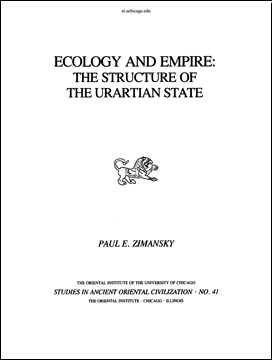SAOC 41. Ecology and Empire: The Structure of the Urartian State Paul E. Zimansky

The literate civilizations of the ancient Near East preserve some of the earliest records of such basic political institutions as the city, national state, and empire. Those interested in such phenomena will welcome this case study of the Urartian state, one of the oldest examples of a complex political system documented in its developing phases by a literate neighbor. Situated in harsh and unpromising terrain just to the north of Assyria, Urartu within a few decades managed through territorial expansion and political alliance to prove itself a dangerous rival of the Assyrian Empire. Paul Zimansky analyzes the resilient superstructure of the Urartian state as a response to its physical and political environment: topography, climate, and the threat of the Assyrian army. Against a detailed geographical background, recreated in part from modern satellite photos, he utilizes a wide range of textual and archaeological materials to present a thesis of cultural adaptation of state structure and organization to ecological exigencies. [From SAOC 41, “Foreword” by J. A. Brinkman]
- Studies in Ancient Oriental Civilization 41
- Chicago: The University of Chicago Press, 1985
- Pp. xv + 141; 15 figures, 15 plates, 17 tables
- 9.00 x 11.75 in.
- Out of Print

